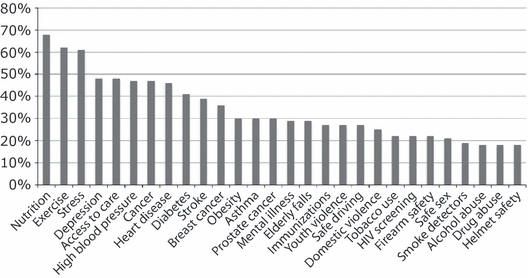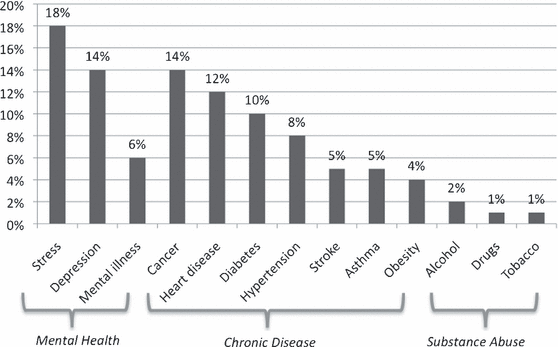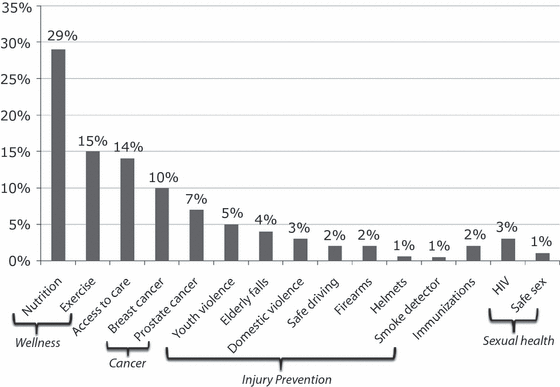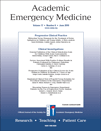Multicenter Study of Preferences for Health Education in the Emergency Department Population
Abstract
Objectives: Emergency departments (EDs) are increasingly proposed as high-yield venues for providing preventive health education to a population at risk for unhealthy behaviors and unmet primary care needs. This study sought to determine the preferred health education topics and teaching modality among ED patients and visitors.
Methods: For two 24-hour periods, patients aged 18 years and older presenting to four Boston EDs were consecutively enrolled, and waiting room visitors were surveyed every 3 hours. The survey assessed interest in 28 health conditions and topics, which were further classified into nine composite health education categories. Also assessed was the participants’ preferred teaching modality.
Results: Among 1,321 eligible subjects, 1,010 (76%) completed the survey, of whom 56% were patients and 44% were visitors. Among the health conditions, respondents were most interested in learning about stress and depression (32%). Among the health topics, respondents were most interested in exercise and nutrition (43%). With regard to learning modality, 34% of subjects chose brochures/book, 25% video, 24% speaking with an expert, 14% using a computer, and 3% another mode of learning (e.g., a class). Speaking with an expert was the overall preferred modality for those with less than high school education and Hispanics, as well as those interested in HIV screening, youth violence, and stroke. Video was the preferred modality for those interested in learning more about depression, alcohol, drugs, firearm safety, and smoke detectors.
Conclusions: Emergency department patients and visitors were most interested in health education on stress, depression, exercise, and nutrition, compared to topics more commonly targeted to the ED population such as substance abuse, sexual health (including HIV testing), and injury prevention. Despite many recent innovations in health education, most ED patients and visitors in our study preferred the traditional form of books and brochures. Future ED health education efforts may be optimized by taking into account the learning preferences of the target ED population.
ACADEMIC EMERGENCY MEDICINE 2010; 17:652–658 © 2010 by the Society for Academic Emergency Medicine
Investigators and policymakers have increasingly viewed emergency departments (EDs) as high-yield venues for providing preventive health education to a population at risk for unhealthy behaviors and unmet primary care needs.1–5 Indeed, ED public health interventions have been proposed for HIV testing,6 alcohol7 and tobacco abuse,8 domestic violence,9 and a host of injury prevention issues such as geriatric falls10 and helmet safety.11 Two single-center studies, based on convenience samples of adult ED patients, suggested that this clinical population was interested in receiving more information on a variety of health conditions and topics.12,13 The delivery of such education could be through several different types of health education modalities. For example, ED-based education has been done using brochures,14,15 computers,16,17 videos,18,19 and public health advocates.20 The preferred method for receiving health education among the ED population is unknown. Thus, the primary objectives of this study were to determine the health conditions and topics of most interest to ED patients and visitors, as well as their preferred learning modality for health education.
Methods
Study Design and Population
The study was a multicenter survey of consecutive ED patients and visitors. The institutional review board governing all hospitals approved the study with a waiver of written informed consent. Verbal consent was obtained for participation.
For two 24-hour periods, ED patients and visitors age ≥18 years were enrolled at four Boston-area EDs: two urban university-affiliated hospitals, one community hospital in an urban setting, and one community hospital in a suburban setting. ED visit volumes ranged from 27,000 to 53,000 patients per year and all are members of the Emergency Medicine Network (http://www.emnet-usa.org), which coordinated the study.
Eligible patients and visitors accompanying patients in examination rooms were enrolled consecutively. In addition, visitors in the waiting room were surveyed every 3 hours. Exclusion criteria included acute distress including intubation, contact precautions, emotional disturbance (e.g., mental illness), acute intoxication (e.g., alcohol), possible sexual assault, and insurmountable language barrier.
Survey Content and Administration
The survey instrument (see Data Supplement S1, available as supporting information in the online version of this paper) presented participants with a list of 13 health conditions and 15 general public health topics; these were further classified into nine composite health education categories, as listed in Table 1. These lists were compiled based on health promotion areas included in the Society for Academic Emergency Medicine (SAEM) Public Health and Education Task Force Report in 2000,2 the Healthy People 2010 Leading Health Indicators,21 and the Institute of Medicine’s report on the Priority Areas for National Action.22 For each of these health conditions and topics, participants indicated whether or not they were interested in learning more about it. Subjects then chose one condition and one topic from the list that they found most interesting and specified their preferred mode of learning more: brochures/book, computer, video, speaking with an expert, or other.
| Health Conditions | Health Topics | |||||||
|---|---|---|---|---|---|---|---|---|
| Mental Health | Chronic Disease | Substance Abuse | Wellness | Cancer | Access To Care | Injury Prevention | Sexual Health | Immunizations |
| StressDepressionMental illness | Heart diseaseStrokeHigh blood pressureCancerObesityAsthmaDiabetes | TobaccoAlcoholDrugs | NutritionExercise | Breast cancer screeningProstate cancer screening | Availability of health care, doctors, and health insurance | Helmet safetyFirearm safetyElderly fallsSafe drivingYouth violenceDomestic violenceSmoke detectors | HIV screeningSafe sex education | Immunizations |
To characterize patients and visitors, we collected sociodemographic data, such as age, sex, race, ethnicity, income, education, primary language, and place of birth. We also collected clinical data, such as primary care provider status, height, weight, and smoking status (never smoked, ex-smoker, or current smoker). Survey questions on sociodemographic characteristics had been used in previous studies by the investigators. The survey was piloted among the investigators to ensure completion in less than 10 minutes.
Trained research assistants approached all eligible subjects, gave a brief description of the survey, and asked subjects if they were willing to participate. The survey was paper-based, anonymous, and self-administered. Surveys were available in English and Spanish, and bilingual research assistants were available for data collection. Research assistants verbally administered the survey for participants who could not read. For self-administered surveys, research assistants returned 15 minutes later to collect responses. A record was kept of eligible subjects who did not complete the survey and their reasons (e.g., ineligible, refused, missed).
Data Analysis
Trained research assistants double-input the data into Microsoft Excel (Microsoft Corp., Redmond, WA) for accuracy. The study sample size was powered for small confidence intervals (CIs) of less than 15% for stratified descriptive analysis within demographic strata. All analyses were performed using Stata 10.1 (StataCorp, College Station, TX). Data are presented as tabulations of proportions.
Results
There were 1,608 patients and visitors who were in the ED or waiting area during the study period. A total of 287 subjects were excluded because they met one of the exclusion criteria. Among 1,321 eligible subjects, 1,010 (76%) completed the survey. Enrolled subjects represented 81% of eligible patients and 72% of eligible visitors. Table 2 describes the characteristics of enrolled participants. A total of 519 (56%) of these were patients, 405 (44%) were visitors, and 86 had an unknown status.
| Characteristics | No. (%) |
|---|---|
| Total | 1,010 |
| Respondents who were ED patients | 519 (56) |
| Age, yr (range) | 40 (29–56) |
| 18–34 | 374 (38) |
| 35–54 | 354 (36) |
| ≥55 | 262 (26) |
| Female | 576 (57) |
| Race/ethnicity | |
| NH White | 606 (64) |
| NH African American | 101 (11) |
| Hispanic | 181 (19) |
| Other | 60 (6) |
| Did not graduate from high school | 129 (14) |
| Non-English primary language | 209 (22) |
| Foreign born | 232 (24) |
| Annual household income | |
| <$40,000 | 359 (50) |
| ≥$40,000 | 353 (50) |
| Primary care visit frequency | |
| Every <6 months | 237 (25) |
| Every 6–12 months | 468 (50) |
| Less than every 12 months | 87 (9) |
| No PCP | 148 (16) |
| BMI | |
| BMI < 30 | 612 (74) |
| BMI ≥ 30 (obese) | 213 (26) |
| Smoking status | |
| Never smoker | 473 (50) |
| Ex-smoker | 234 (25) |
| Current smoker | 237 (25) |
- BMI = body mass index; NH = non-Hispanic; PCP = primary care provider.
Almost all (98%) respondents indicated interest in learning about one or more health condition or topic out of the 28 listed, with a mean of 4.7 listed per respondent. Figure 1 shows the overall interest in each health condition or topic.

Overall interest in 28 health conditions and topics. Bars represent proportion of ED patients and visitors (%).
Respondents were asked to select the health condition and topic of most interest. Among health conditions, respondents were most interested in stress (18%); this interest was fourfold higher than all forms of substance abuse combined (Figure 2). Among health topics, there was most interest in the wellness-related topics of nutrition and exercise, accounting for a combined 44% of respondents’ first choice (Figure 3). There was half as much interest in injury prevention topics overall (21%), with sexual health, including HIV screening (5%), and immunizations (2%) garnering the least interest.

Health condition of most interest. Bars represent proportion of ED patients and visitors (%).

Health topic of most interest. Bars represent proportion of ED patients and visitors (%).
When asked about preferred education modality, 34% of all subjects chose brochures or a book, 25% video, 24% speaking with an expert, 14% using a computer, and 3% another mode of learning (e.g., a class). Although brochures and books were the preferred modality overall, there were notable exceptions among certain conditions and topics (Table 3). Speaking with an expert was the preferred modality for those interested in HIV screening, youth violence, and stroke. Video was the preferred modality for those interested in learning more about depression, alcohol, drugs, firearm safety, and smoke detectors.
| Brochure or Book | Video | Speaking With an Expert |
|---|---|---|
| StressCancerHeart diseaseDiabetesHypertensionAsthmaNutritionExerciseAccess to careBreast cancerProstate cancerDomestic violenceSafe drivingImmunizationsHelmet safetyMental illness (tie)Obesity (tie)Tobacco (tie)Elderly falls (tie)Safe sex (tie) | DepressionAlcoholDrugsFirearm safetySmoke detectorMental illness (tie)Obesity (tie)Tobacco (tie) | StrokeHIV screeningYouth violenceElderly falls (tie)Safe sex (tie) |
- “Computer” and “other”: not preferred modality for any health condition or topic.
Preferences for education modality were also broken down by the demographic characteristics listed in Table 2. Brochures and books were the most preferred method across categories with a few exceptions. Speaking with an expert was the preferred method for participants who were Hispanic (32%) and had less than high school education (32%). Video was the preferred modality for men (29%) and obese patients (31%). For the major descriptive outcomes (e.g., preferred health education topics and preferred teaching modalities) there were no material differences between different sites and by comparing university-based versus community hospitals (data not shown).
Discussion
In this multicenter survey of ED patients and visitors, we report strong interest in learning about a variety of health condition and topics. Surprisingly, interest was highest for wellness topics (such as exercise and nutrition), mental health conditions (stress and depression), cancer, chronic medical conditions, and health care access. Research on health promotion in the ED focusing on wellness, chronic medical conditions, and cancer has not been a priority of emergency medicine public health research.23
In contrast, we found that ED patients and visitors had relatively little interest in injury prevention, sexual health, and substance abuse, which account for a high proportion of directly preventable ED visits.24 These important topics constituted three of the four priority areas for the 2009 SAEM Consensus Conference, “Public Health in the Emergency Department: Surveillance, Screening, and Intervention—Injury Prevention/Intimate Partner Violence, Sexually Transmitted Diseases/HIV, and Alcohol and Substance Abuse.”25 The fourth priority area was mental health disorders, which, based on our data, overlaps most with the actual preferences of ED patients and visitors. Our multicenter study confirms findings of the single-center study by Llovera et al.13 of 878 New York ED patients’ interest in 21 health education topics. Respondents in that study, as well as ours, were most interested in stress reduction and exercise, with the least amount of interest in injury prevention, HIV, and substance abuse topics.
To the best of our knowledge, the discrepancy between emergency medicine–public health investigators and ED patients on priorities for ED-based health education has not been addressed previously. Future studies are needed to elucidate why ED patients report that they are not as interested in the health education issues related to preventable illnesses and injuries seen commonly in the ED. Given that ED patients and visitors are likely to be focused on their acute health problem, efforts to provide health education as an adjunct to acute care may be more effective if they reflect the interests of the recipients.
To our knowledge, this also is the first study to evaluate preferred education modalities in an ED population across a wide variety of health conditions and topics. Despite the many advances in health education, traditional brochures and books were the preferred method, both overall and for 20 of 28 health conditions and topics. Given the high acceptance and low cost of printed materials, brochures may be a feasible way to implement health education more broadly in the ED.
Of the health conditions and topics surveyed, there has been the most research assessing the effectiveness of distributing printed materials for asthma.26 Distributing information alone for adults with asthma in the ED has been shown to reduce rehospitalizations and reduce health care costs.26 However, the lack of interaction in distributing written materials has been cited as a reason for limited effectiveness in changing health behaviors. For instance, in a study of preventive health pamphlets encouraging Pap smears distributed to ED patients, only 65% of the women reached at follow-up had read the pamphlet, and only 11% scheduled a Pap smear.27 More research is needed to assess the effectiveness distributing brochures in the ED on outcomes for other diseases.
For potentially sensitive issues such as HIV, safe sex, and youth violence, speaking with an expert was the preferred modality. Speaking with an expert was also the preferred modality among Hispanic participants and those with less than high school education. This may be partially explained by lower levels of health literacy in these groups, leading to perceived difficulty in understanding written information in a brochure. Respondents also indicated that speaking with an expert would be preferred for stroke and falls by elders. This cannot be accounted for by age, as participants older than 55 had a relatively high preference for learning by brochures (38%) compared to speaking with an expert (22%). Thus, this may reflect the complexity of these issues for older patients. These findings also highlight that these sensitive and complex issues may need additional counseling in addition to the information provided with discharge information sheets.
Video was the preferred modality for substance abuse conditions (alcohol, drugs, and tobacco), depression, mental illness, obesity, and some injury prevention topics (firearms and smoke detectors). When stratified by demographic characteristics, video was the preferred modality for men (29%) and obese participants (31%). Most health education in the ED for substance abuse and injury prevention to date has been through counselors20 and computers.16,28 Although video has been used for ED health education on asthma,29 HIV,19 stroke,18 and some types of discharge instructions,30 there has been little research on using it to provide health education in the ED on other topics. Our findings suggest that video may represent an important modality for patient acceptance of health education related to substance abuse, mental health, and some injury prevention topics.
Despite several recent studies on using computers for health education and screening in the ED, computers were not the preferred education modality for any of the 28 health conditions and topics. While these preferences may change over time, our findings suggest that more research is needed to compare the effectiveness and acceptance of computer health education modalities in the ED setting to video and brochures before advocating for widespread dissemination. However, we are not sure that self-reported lack of interest in computer-based education is an accurate predictor of engagement or behavior change, and it remains possible that a well-designed computer-based intervention might in fact be quite effective. One potential advantage of computers relative to personal counseling is that they offer anonymity. In fact, some studies have shown that ED computer-based screening improves the detection of rates of sensitive health issues and risk factors compared to personal interviewing.31
It is unknown whether people’s self-reported preferences are an accurate reflection of which modalities would in fact attract their attention or lead to behavior change. In general, there are few studies analyzing the comparative effectiveness of pamphlets to video, computers, and counseling for health education in the ED setting. In the few studies that have been done, more interactive and proactive methods have been associated with better outcomes.24 One example is personal counseling versus written information in reducing risky drinking behavior in ED patients.32 A systematic review of the health education literature has shown that patient-level factors such as sociodemographic and health characteristics are well correlated with the acceptance of health education interventions.33 For example, less-educated patients in our study preferred speaking with an expert over brochures. While some studies evaluating health education programs in the ED have shown higher levels of patient satisfaction with the study intervention over a control intervention, study subjects are typically randomized to the interventions.16 Thus, these traditional study designs are unable to assess the effect of initial preference for a certain learning modality on subsequent behavior change. This is an area for future investigation.
In a broader context, the rising number of people visiting EDs represents an important opportunity for providing health education. In 2006 alone, 119 million visits were made to U.S. EDs, and the number continues to rise.34 Given that 98% of ED patients and visitors in our study are interested in receiving some health education, ED waiting rooms may prove an excellent venue to deliver health information to a captive and interested audience.30
Limitations
Patients who were distressed, intoxicated, or emotionally disturbed and victims of sexual violence were excluded because of inability to provide voluntary informed consent, thus leading to a likely selection bias. In practice, these groups would be unlikely to engage in health education at the time of this ED visit. The same survey was used for all research participants. This may have introduced bias based on the ordering of survey items. All four study sites were in the Boston area, which may limit generalizability to other regions of the country. However, the relative levels of interest in health conditions and topics were similar to single-center studies in New York and Los Angeles. Children were not included, thus leaving a knowledge gap on issues important to the adolescent population and parents of younger children. Finally, while establishing ED patient and visitor preferred teaching modalities is an important component of implementing ED health education, additional research is needed to compare the actual effectiveness of different health education topics and modalities on health behaviors and outcomes.
Conclusions
We found that almost all patients and visitors in four Boston-area EDs were interested in learning about at least one health condition or topic. Surprisingly, there was more interest in the wellness-related topics of exercise and nutrition, mental health conditions, cancer, health care access, and chronic medical conditions compared to topics more commonly targeted to the ED population such as substance abuse, sexual health (which includes HIV testing), and injury prevention. Despite many recent innovations in health education, we found that most ED patients and visitors in our study reported that they would prefer the traditional form of books and brochures. By taking into account preferences and characteristics of the target population, ED health education efforts may be optimized.
Acknowledgments
The authors thank Drs. Jeff Collins (Chelsea HealthCare Center) and Richard Larson (Faulkner Hospital) for their participation and also Karen Bos, Gabrielle Hunter, and Dr. Sunghye Kim of the EMNet Coordinating Center for their important logistical contributions. Dr. Delgado was supported by AHRQ training grant T32 HS00028 to the Center for Primary Care and Outcomes Research, Stanford University.




